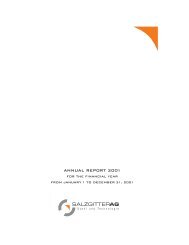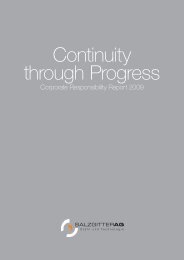Download - Salzgitter AG
Download - Salzgitter AG
Download - Salzgitter AG
Create successful ePaper yourself
Turn your PDF publications into a flip-book with our unique Google optimized e-Paper software.
B Consolidated Annual Financial Statements/Notes V. Notes to the Consolidated Financial Statements of <strong>Salzgitter</strong> <strong>AG</strong> 234 235<br />
IAS 20 stipulates that grants may not be reported in the balance sheet until the necessary claim<br />
prerequisites have been fulfilled and it can be anticipated that the grants will actually be paid out. In<br />
principle, grants related to assets are reported as deductions from acquisition or production costs.<br />
Insofar as a grant related to income refers to future financial years, it is reported using the accrual<br />
method, and the component for future periods is transferred to an accrued item.<br />
Impairment of Assets (Impairment Test)<br />
On each balance sheet date, the Group examines the book values of its intangible assets and property,<br />
plant and equipment to establish whether there is an event which could trigger impairment. If such<br />
signs are discernible, the recoverable amount is estimated in order to determine the scope of the<br />
impairment. If the recoverable amount for the individual asset cannot be estimated, the estimate is<br />
made at the level of the cash generating unit (CGU) to which the asset belongs. Impairments are<br />
carried out if the benefit deriving from the asset is lower than its book value. The benefit deriving from<br />
an asset corresponds to the net selling price or the value in use, whichever is higher. The value in use<br />
is determined by the net present value of future cash flows attributable to the asset. If the reason for<br />
a previous special depreciation no longer applies, a write-up is carried out.<br />
Non-current assets that are classified as held for sale are reported at the carrying amount or the<br />
lower fair valueless costs to sell.<br />
Financial Risk Management<br />
The Group’s business activities expose it to a variety of financial risks: the market risk (includes the<br />
currency risk, the interest rate risk and the market price risk), the credit risk and the liquidity risk. The<br />
Group’s overall risk management program is focused on the unpredictability of developments in the<br />
financial markets and seeks to minimize potential adverse effects on the Group’s financial position.<br />
Risk management is carried out independently by the subsidiaries and associated companies of<br />
<strong>Salzgitter</strong> <strong>AG</strong> in accordance with policies approved by the Executive Board. The Executive Board issues<br />
written principles for overall risk management as well as guidelines for specific areas, such as the<br />
currency risk, the interest rate and credit risk, the use of derivative and non-derivative financial instruments<br />
and the investment of excess liquidity.<br />
Currency risk<br />
The Group operates internationally and is therefore exposed to a currency risk based on fluctuations<br />
in the exchange rates between various foreign currencies. Currency risks arise from expected future<br />
transactions and assets and liabilities reported in the balance sheet. The risk arises when transactions<br />
are denominated in a currency that is not the functional currency of the company. The Group companies<br />
use forward exchange contracts to hedge against such risks.<br />
Consolidated Annual<br />
Financial Statements











